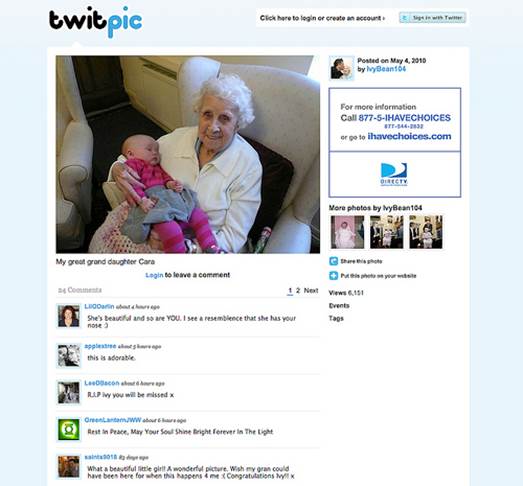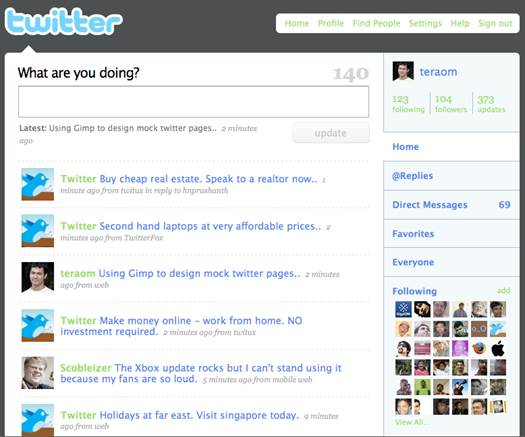Many people think Twitter is full of
twaddle. Computeractive puts the social network for chatterboxes on trial and
explains how it works
Rarely has a website had such an apt name
as Twitter. The social network is all about chatter, and it’s seemingly talked
about incessantly everywhere else. The hype can be tedious but lurking behind
it, is there really a brilliant, entertaining, informative tool that you could
be using? Among the millions of trivial messages published daily, are there
some that you would find interesting? If so, how would you spot them?
In this article we’ll put Twitter on trial,
offering a measured assessment of what’s good and bad about it. We will explain
what Twitter is, who’s using it and what for. And if you want to try tweeting,
we’ll show you to how to join in and get the best from it.
What is Twitter?

Twitter
is an online service that allows users to create and read text messages of no
more than 140 characters
Simply put, Twitter is an online service
that allows users to create and read text messages of no more than 140
characters. A user’s ‘tweets’, as they’re known, are usually publicly visible
on their profile webpage, although it is possible to limit them to approved
people or to send a private message to another user.
Twitter users see a ‘timeline’ of tweets
published by themselves and the people they ‘follow’. To follow someone, you
simply visit their profile page and click the ‘Follow’ button. The service
first appeared in 2006, initially as a way to communicate with a group of
people using a single SMS text message. Within a year there was considerable
enthusiasm for Twitter among technology and media types. This early popularity
encouraged others to join but also left many people with the impression that
Twitter was an ‘in-club’ for media professionals and celebrities.
Even if this was true in its early days,
Twitter has now entered the mainstream. It claimed to have 100 million
active users at the last count, but they aren’t just the media darlings,
teens and self-promoters you might fear.
Research conducted by the Pew Research
Center in America (www.pewinternet.org)
suggests that Twitter is more popular with female internet users than males and
that it is used by people of all ages. At the time of her death in 2010,
the world’s oldest known Twitter user, Ivy Bean, was 104. In short, Twitter’s
users are a broad cross-section of society.
What’s in a tweet?

Ivy
Bean became Twitters’s oldest user at the age of 104
Just because there’s a mix of interesting
people on Twitter, it doesn’t necessarily follow that their tweets will be of
interest. This may be a disappointment for those following updates from a favorite
actor, musician or comedian, only to discover that they’re distinctly less
fascinating than expected. In 2009, Stephen Fry, perhaps the archetypal Twitter
celebrity, famously threatened to quit the service after a follower confessed
to finding his tweets “a bit… boring”. Perhaps inevitably, he didn’t leave and
Fry now has over three million Twitter followers.
While many do find Fry and other
celebrities worth following, it’s all too easy for any user to post inane or
tedious updates about, say, an overcooked dinner or a visit to the shops. A
frequent criticism of Twitter is that even when exercising self-restraint, it’s
impossible to craft anything worthwhile from 140 characters. Many tweets are
bland or trivial. A 2009 study (www.snipca.com/X4911)
labeled 40 per cent ‘pointless babble’ and a further 38 per cent
‘conversational’, but there are also historically interesting tweets, such as
Barack Obama’s tweet following his 2008 presidential election victory: “We just
made history. All of this happened because you gave your time, talent and
passion. All of this happened because of you. Thanks.”

The
restricted length of tweets means the medium is ideally suited to the distribution
of news
The restricted length of tweets means the
medium is ideally suited to the distribution of news, with just enough room for
a typical headline or summary along with a web link leading to a longer
article. Unlike Facebook, however, the service wasn’t originally designed to
handle images or messages longer than 140 characters, preventing tweets from
telling the full story. While it still isn’t possible to add an image directly
to a tweet, numerous services exist that let users upload one to a webpage and
include a short link to it instead, making efficient use of the 140-character
limit.
Importantly, you don’t need to have a
Twitter account or be an active user to find news on the site. Just visit www.twitter.com/search to look for a
topic or trend of interest. Twitter’s search engine will return relevant news,
tweets, users and images.
Most major news outlets now use Twitter
feeds to distribute headlines, such as the BBC’s @BBCBreaking account (we’ll
explain more about the make-up of Twitter names a little later), but Twitter’s
accessibility means that smaller news outlets and even individuals can use it
to circulate information.
Much has been made of this fast propagation
of news and eyewitness accounts, with Twitter’s speed and reach sometimes
credited with having helped protesters to outmaneuver oppressive regimes.
Alongside Facebook, the network played a high-profile role in organizing and
publicizing the events of the Arab Spring – the wave of revolution in Arab
nations that began in December 2010.